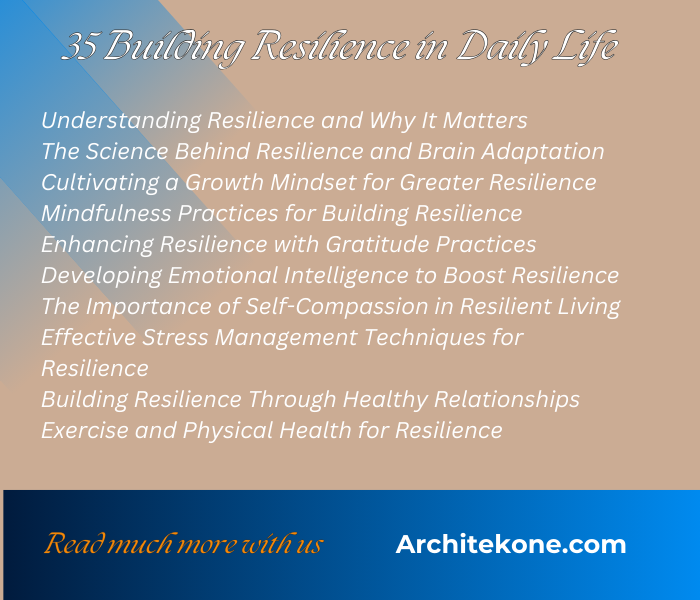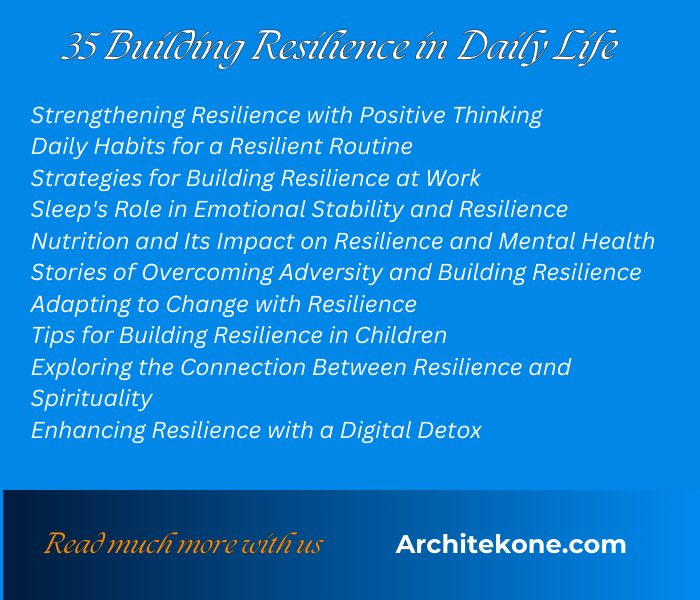On the path to resilience, transforming our capacity to handle life’s inevitable challenges with grace and strength becomes paramount. The 35 strategies outlined in this guide are designed to integrate resilience into daily life, offering practical steps that anyone can take to cultivate a robust and adaptable mindset. Whether you’re looking to improve your emotional intelligence, foster stronger relationships, or manage stress more effectively, these techniques provide a comprehensive toolkit for building resilience. By incorporating these strategies, you’ll not only strengthen your ability to bounce back from adversity but also enhance your overall well-being and quality of life. Join us as we explore how to weave resilience into the fabric of your daily routines, empowering you to thrive in the face of any situation.

Understanding Resilience and Why It Matters
Resilience is often described as the capacity to withstand stress and catastrophe. It’s about bouncing back from difficulties with a positive attitude and a sense of mastery. This skill is increasingly critical in today’s world where adversity and stress are prevalent. Resilience doesn’t eliminate stress or erase life’s difficulties, but it does provide the tools to cope with and rise above them. Cultivating resilience can lead to a transformation in how we live and deal with challenges, making it an invaluable trait in both personal and professional realms.
The Science Behind Resilience and Brain Adaptation
At the core of resilience is the brain’s ability to adapt to adversity. When faced with stress, the brain undergoes both chemical and functional changes which can affect overall behavior and emotions. Research has shown that this adaptability, known as neuroplasticity, allows the brain to reorganize itself by forming new neural connections throughout life. These changes are influenced by behaviors, environment, and neural processes. Practices that challenge the brain, like learning new skills or engaging in complex problem-solving, can enhance this plasticity and, consequently, resilience.
Cultivating a Growth Mindset for Greater Resilience
The concept of a growth mindset, developed by psychologist Carol Dweck, is pivotal in building resilience. This mindset thrives on challenge and sees failure not as evidence of unintelligence but as a heartening springboard for growth and for stretching our existing abilities. With a growth mindset, an individual is more likely to persevere through difficulties, viewing them as natural and helpful in learning and personal development. By fostering a growth mindset, one can cultivate resilience by seeing life’s inevitable setbacks as opportunities to learn and evolve.
Mindfulness Practices for Building Resilience
Mindfulness, the psychological process of bringing one’s attention to experiences occurring in the present moment, can be developed through meditation and other training. Engaging in mindfulness exercises such as guided imagery, breathing techniques, and meditation can help decrease stress responses and enhance emotional regulation. Regular practice leads to a better mood, increased patience, and improved overall mental health, contributing significantly to building resilience.
Enhancing Resilience with Gratitude Practices
Gratitude practices are an effective strategy for enhancing resilience. Regularly expressing gratitude can shift attention away from toxic emotions, such as resentment and envy, and towards more positive ones. Simple practices like maintaining a gratitude journal or taking time each day to reflect on what you are thankful for can improve psychological health, support resilience, and lead to a happier and more fulfilled life.
Developing Emotional Intelligence to Boost Resilience
Emotional intelligence (EI), the ability to identify, understand, and manage our own emotions and the emotions of others, is a cornerstone of resilience. High EI contributes to the development of coping mechanisms that handle stress effectively. Enhancing EI can be achieved through self-awareness, which involves recognizing our emotions and their impact; self-management, which involves controlling our emotional responses; social awareness, which entails understanding the emotions of others; and relationship management, which focuses on developing healthy interactions.
The Importance of Self-Compassion in Resilient Living
Self-compassion involves being kind to one’s self in instances of failure or when noticing one’s inadequacies, rather than being harshly self-critical. It also encompasses viewing one’s mistakes as part of the human experience. Practicing self-compassion can foster resilience by reducing the impact of negative experiences and promoting a forgiving attitude. This not only enhances one’s ability to bounce back but also supports a balanced approach to dealing with challenges.
Effective Stress Management Techniques for Resilience
Effective stress management is crucial for developing resilience. Techniques such as time management, setting realistic goals, and practicing relaxation exercises can help manage stress levels. Learning to prioritize work, taking regular breaks, and establishing boundaries are also vital strategies. Moreover, techniques like progressive muscle relaxation, deep breathing exercises, and visual imagery can provide immediate relief in stressful situations and increase one’s long-term resilience.
Building Resilience Through Healthy Relationships
Strong, positive relationships are a key component of resilience. Being connected to others provides emotional support, which can help weather personal storms. Cultivating supportive relationships, whether through family, friends, or community groups, can offer encouragement and shared joy, making it easier to cope with trials. Efforts to build trust, practice empathy, and support others not only strengthen these bonds but also reinforce an individual’s capacity for resilience.
Exercise and Physical Health for Resilience
Physical health plays a significant role in psychological resilience. Regular physical activity, such as running, yoga, or team sports, boosts endorphins and reduces stress hormones like cortisol. Additionally, exercise can improve sleep, enhance mood, and reduce anxiety and depression, all of which contribute to greater emotional durability. Ensuring a balanced diet and adequate sleep further supports physical health, creating a strong foundation for resilience.

Strengthening Resilience with Positive Thinking
Positive thinking is more than mere optimism; it is a powerful tool for building resilience. By actively reframing negative situations into learning opportunities, individuals can foster a mindset that not only withstands adversity but also thrives in the aftermath. Positive thinking encourages a problem-solving attitude, reduces the impact of stress on the mind and body, and aligns individuals with their core values and goals, thus enhancing their ability to bounce back from challenges.
Daily Habits for a Resilient Routine
Incorporating specific habits into daily routines can significantly enhance resilience. Practices like setting clear daily goals, maintaining a regular exercise regimen, and allocating time for reflection can stabilize one’s mental health. Furthermore, habits such as prioritizing important tasks, practicing gratitude, and committing to personal growth tasks each day can solidify a routine that fosters resilience. These consistent practices help individuals develop the capacity to manage stress effectively and recover from setbacks more swiftly.
Strategies for Building Resilience at Work
Resilience in the workplace is crucial for handling the fast-paced and often stressful environments that characterize modern work settings. Strategies to enhance resilience at work include fostering strong relationships with colleagues, setting realistic career goals, and seeking constructive feedback for improvement. Additionally, developing clear communication skills and adapting to change are vital. Employers can support resilience by promoting a positive work culture, providing support resources, and encouraging work-life balance.
Sleep’s Role in Emotional Stability and Resilience
Sleep is a foundational element of emotional stability and resilience. Quality sleep rejuvenates the brain, regulates mood, and sharpens decision-making abilities. Lack of adequate sleep, conversely, can contribute to irritability, decreased motivation, and increased susceptibility to stress. Establishing a regular sleep schedule, creating a restful environment, and prioritizing sleep hygiene can significantly improve one’s resilience and overall emotional health.
Nutrition and Its Impact on Resilience and Mental Health
Nutrition plays a critical role in mental health and resilience. A diet rich in antioxidants, omega-3 fatty acids, and vitamins can enhance cognitive function and mood stability, which are essential for resilience. Conversely, a diet high in processed foods and sugars can exacerbate feelings of anxiety and depression. Mindful eating practices, such as paying attention to hunger cues and making dietary choices that align with one’s health needs, are crucial for maintaining mental health and resilience.
Stories of Overcoming Adversity and Building Resilience
Personal stories and case studies of individuals who have overcome adversity serve as powerful examples of resilience. These narratives often share common themes such as persistence, learning from failure, and the importance of support networks. Sharing these stories can inspire others to develop resilience by providing real-life examples of people who have faced challenges and emerged stronger, thereby illustrating the potential for growth and recovery in the face of adversity.
Adapting to Change with Resilience
Adapting to change is a vital component of resilience. This ability involves accepting that change is a part of life and approaching it with flexibility rather than resistance. Strategies for adapting include staying informed about changes, planning for various scenarios, and maintaining an open mind. Building resilience in the face of change allows individuals to manage transitions more effectively and maintain their well-being in varying circumstances.
Tips for Building Resilience in Children
Building resilience in children is fundamental for their development and future well-being. Key strategies include teaching them problem-solving skills, encouraging them to express and manage their emotions, and fostering secure attachments through consistent support and love. Moreover, allowing children to experience manageable levels of stress with supportive guidance can teach them to navigate challenges independently, equipping them with the skills to cope with future obstacles.
Exploring the Connection Between Resilience and Spirituality
Spirituality can be a profound source of resilience. Many find that their spiritual practices, beliefs, and communities provide them with a sense of purpose, hope, and connection that fortifies them against life’s challenges. Whether through meditation, prayer, or communal worship, spirituality can offer solace and strength, enhancing one’s capacity to recover from setbacks.
Enhancing Resilience with a Digital Detox
In an age where digital connectivity is omnipresent, taking time to disconnect can significantly boost resilience. A digital detox involves stepping away from electronic devices to reduce stress and improve presence of mind. This practice helps individuals regain focus, enhance real-life interactions, and develop a healthier relationship with technology. Regular digital detoxes can lead to improved sleep, better interpersonal relationships, and greater emotional stability, all of which contribute to building resilience.

Building Resilience Through Acceptance and Letting Go
Building resilience often requires the ability to accept circumstances that cannot be changed and to let go of the past. This process involves recognizing the limits of one’s control over external events and focusing instead on one’s response to them. Acceptance is not about passive resignation but rather about choosing to move forward without the burden of unresolved emotions or grudges. Techniques such as mindfulness and cognitive reframing can aid in this transition, facilitating a more adaptable and resilient mindset.
Harnessing Community Power for Greater Resilience
The strength of community connections is a crucial factor in enhancing resilience. Communities can provide emotional support, practical assistance, and a sense of belonging, all of which fortify individuals against life’s challenges. Participating in community activities, seeking support from local groups, or simply fostering relationships with neighbors can enhance one’s ability to cope with personal and collective crises. The shared resources and networks available within a community are invaluable tools for building resilience.
Thriving in Later Years with Resilience in Aging
Resilience is especially important in later years as older adults face unique challenges such as health issues, the loss of loved ones, and often, a change in living situations. Cultivating resilience can significantly improve their quality of life, enabling them to adapt to these changes with grace. This can be achieved through maintaining physical health, engaging in social activities, and pursuing lifelong learning—all of which contribute to a robust, resilient spirit in the face of aging.
Fostering Resilience with Creativity and Play
Creativity and play are not just for children; they are vital for adults too, serving as powerful tools for building resilience. Engaging in creative activities such as painting, writing, or music allows individuals to express themselves and process complex emotions in a healthy way. Play, on the other hand, can alleviate stress, improve brain function, and stimulate problem-solving abilities. Both creativity and play offer opportunities for growth and adaptation, which are key components of resilience.
Navigating Technology and Change with Resilience
In the rapidly evolving digital age, resilience involves adapting to technological changes and the challenges they bring. This includes learning new tools and platforms, staying informed about technological advancements, and managing the stress associated with digital transformation. Developing digital literacy and maintaining a flexible mindset are essential for navigating these changes effectively and resiliently.
The Role of Nature in Building Resilience and Well-Being
Exposure to nature is not only rejuvenating but also significantly enhances psychological resilience and well-being. Natural environments offer a refuge from the urban hustle, reducing stress, enhancing mood, and improving physical health. Activities such as hiking, gardening, or simply spending time in green spaces can help reset one’s mental state and boost resilience. The restorative power of nature plays a critical role in maintaining balance in one’s life.
Managing Money with Confidence for Financial Resilience
Financial resilience is critical for managing life’s unpredictabilities with confidence. This involves creating and maintaining a budget, saving for emergencies, investing wisely, and managing debts effectively. Financial education plays a key role in this area, as it equips individuals with the knowledge to make informed financial decisions, leading to greater security and reduced stress.
Building Resilience with the Power of Forgiveness
Forgiveness is a powerful aspect of building resilience, as it involves releasing resentment and anger towards others or oneself. This process can lead to healthier relationships, improved mental health, and greater emotional relief. The act of forgiving does not mean forgetting or excusing the harm done but rather letting go of the grip that negative emotions have on one’s life. By embracing forgiveness, individuals can reclaim peace of mind and foster a resilient spirit.

Finding Work-Life Balance and Resilience
Achieving a healthy work-life balance is essential for resilience, as it helps manage stress and prevent burnout. This balance means different things to different people, but generally involves allocating time wisely between work responsibilities and personal activities. Strategies such as prioritizing tasks, setting realistic work hours, and learning to say no can significantly aid in maintaining this balance. By creating a more flexible schedule that allows for periods of rest and personal pursuits, individuals can maintain their productivity and safeguard their mental health.
Boosting Resilience and Self-Reflection with Journaling
Journaling is a powerful tool for self-reflection and building resilience. It allows individuals to express thoughts and feelings on paper, which can help process emotions and clarify thoughts. Regular journaling can lead to greater self-awareness, helping to identify triggers and coping mechanisms that work best for the individual. This practice can also track personal growth and emotional recovery, providing a valuable outlet for stress relief and mental clarity.
Building Emotional Resilience with Humor
Humor is a potent tool for enhancing emotional resilience. It provides a way to view problems from a different perspective, often lightening the emotional load of difficult situations. Laughter itself can reduce stress hormones, increase endorphins, and improve overall mood. By incorporating humor into daily life, individuals can face challenges with a lighter heart and a more balanced outlook, making it easier to recover from setbacks.
Overcoming Perfectionism for a Resilient Life
Perfectionism can be a significant barrier to resilience, as it often leads to excessive self-criticism and fear of failure. Overcoming perfectionism involves accepting that mistakes are a natural part of learning and growth. By setting more realistic goals and celebrating small successes, individuals can develop a healthier approach to personal and professional endeavors. This shift in mindset encourages a more flexible approach to challenges, enhancing personal resilience.
Building Stronger Bonds with Resilience in Relationships
Resilience in relationships involves the ability to navigate through conflicts and challenges together. This can be fostered by developing strong communication skills, showing empathy, and supporting each other’s growth. Resilient relationships are built on trust and mutual respect, where both parties feel safe to express themselves openly. Such bonds not only withstand stress but also provide a vital support network that contributes to individual and collective resilience.
Setting Boundaries for Personal Resilience
Setting boundaries is crucial for maintaining personal resilience. It involves knowing and communicating one’s limits in personal and professional relationships. Effective boundaries protect individuals from overcommitment and help manage their energy levels. They are not about isolation but about prioritizing self-care and respect, essential components of a resilient lifestyle.
The Journey of Personal Growth and Resilience
The journey of personal growth and resilience is an ongoing process that involves continual self-evaluation and adjustment. It includes learning from experiences, adapting to new situations, and developing emotional strength. This path may involve seeking new challenges, stepping outside comfort zones, and learning new skills. Each step on this journey not only builds resilience but also enriches the individual’s life, making them better equipped to handle future challenges.

